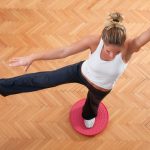
Dynamic Postural Stabilization
Posture in motion requires simultaneous movement and stabilization. As you move one part of the body, you must stabilize another to have balanced movements. Without adequate stabilization of the Posture System during movement you run the risk of injury.
Think about it, if you want to kick a soccer ball with your right foot, you stabilize the weight of your body to support upright posture in motion  with the left leg and hip. Allowing full range of motion of the right leg to kick the ball.
with the left leg and hip. Allowing full range of motion of the right leg to kick the ball.
What would happen if you went to kick a soccer ball and you didn’t stabilize on your non-kicking leg? How would it feel if you threw a baseball pitch but didn’t have axial stabilization of the midline of your body?
Kicking a soccer ball without stabilization would result in an uncoordinated movement and possibly an injury of the lower extremity. And if you threw a fast pitch without proper stabilization of the trunk, imagine how you would buckle forward when you released the ball!
Our bodies are dynamic, we are born to move with athleticism. To achieve optimal fluidity and coordination upon movement, focus on postural stabilization, core strength, and refined motor skill training. These three components are the vital to every postural correction rehabilitation program for optimal mobility and stability simultaneously during movement.
According to Horak (2006), the two main functional goals of dynamic posture are postural orientation and postural equilibrium. Postural orientation involves the active alignment of the trunk and head with respect to gravity, support surfaces, the visual surroundings, and internal  reference of the structure of the body. Postural orientation is determined as a result from the integration of incoming information from the somatosensory, vestibular, and visual systems.
reference of the structure of the body. Postural orientation is determined as a result from the integration of incoming information from the somatosensory, vestibular, and visual systems.
Postural equilibrium involves the coordination of movement strategies to stabilize the center of body mass during both self-initiated and externally triggered disturbances of stability. Postural stabilization during dynamic movement keeps you upright against gravity while moving in space. Anticipatory postural adjustments, prior to voluntary limb movement, serve to maintain postural stability by compensating for destabilizing forces associated with moving a limb (Horak, 2006).
Dynamic postural presentation also has an affect on energy levels. Bad posture slowly siphons off your energy. When you slouch, your muscles have to work harder just to hold you up, this can tire the body faster and adds extra stress to the body. In fact, just 15 minutes of sitting in the wrong position exhausts the neck, shoulders and upper-back muscles (Riddle & Purvis, 2004).
If that is the case while seated, imagine how much your body is affected from improper stabilization during athletic movements! To save your energy and utilize your energy expenditure for complex movements, focus on the importance of proper postural stabilization during dynamic movement.
Dynamic postural stabilization is also reliant on strong core musculature. The core musculature protects the spine from injury, allowing you to move your upper and lower extremities without injuring your back.
Sato and Mokha (2009) performed a research study demonstrating the importance of core development for improvement of athletic performance. They determined that 6 weeks of core stability training improved overall running performance in recreational and competitive runners. In fact, with stronger core musculature, the runners were faster, thus demonstrating a higher level of athletic results.
Many athletes underestimate the importance of posture for improved athleticism. To take your game to the next level recognize the value of postural stabilization to perform movements more accurately, with less energy expenditure or fatigue, and with more precision to prevent injuries.
References:
Horak, F. (2006) Postural orientation and equilibrium: what do we need to know about neural control of balance to prevent falls? Age Ageing, 35 (suppl 2): ii7-ii11.
Riddle, J., & Purvis, L. (2004). 10 WAYS TO BOOST YOUR ENERGY. Essence (Time Inc.), 35(2), 93-97.
Sato, K., & Mokha, M. (2009). DOES CORE STRENGTH TRAINING INFLUENCE RUNNING KINETICS, LOWER-EXTREMITY STABILITY, AND 5000-M PERFORMANCE IN RUNNERS? Journal of Strength and Conditioning Research, 23(1), 133-40. Retrieved from http://search.proquest.com.library.capella.edu/docview/213041059?accountid=27965











